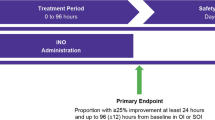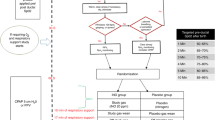Abstract
Objective:
The purpose of this study was to evaluate the demographic characteristics and outcomes of neonates who were admitted to a neonatal intensive care unit and treated with inhaled nitric oxide (iNO) during the years 2000–08. The goal of studying this group of neonates was to evaluate how iNO use has evolved in infants and to estimate the frequency of off-label use of this drug in this population.
Study Design:
Retrospective review of the Pediatrix Clinical Data Warehouse de-identified data set. Pediatrix Medical Group provides intensive care services in 244 hospitals in 32 states and Puerto Rico. Nine (3.7%) centers provide extracorporeal membrane oxygenation.
Result:
There were 494 255 neonates in the data set; 4316 (0.9%) were treated with iNO. The use of iNO increased from 154 of 32 967 patients in 2000 to 921 of 75 911 patients in 2008; a 2.6-fold increase (0.47 to 1.23%). There were 155 872 infants <34 weeks estimated gestational age discharged between 1 January 2000 and 31 December 2008; 1656 (1.1%) were treated with iNO. Since approval in 2000, the reported use of iNO in neonates <34 weeks increased from 0.3 to 1.8% in 2008; a sixfold increase in the reported use of iNO. The biggest increase occurred in infants between 23 and 26 weeks’ gestational age (0.8 to 6.6%). In contrast, the increase in iNO use among neonates born ⩾34 weeks has only increased from 0.5 to 1%.
Conclusion:
The use of iNO has increased and the greatest increase has been the off-label use among preterm neonates.
This is a preview of subscription content, access via your institution
Access options
Subscribe to this journal
Receive 12 print issues and online access
$259.00 per year
only $21.58 per issue
Buy this article
- Purchase on Springer Link
- Instant access to full article PDF
Prices may be subject to local taxes which are calculated during checkout

Similar content being viewed by others
References
Finer NN, Barrington KJ . Nitric oxide for respiratory failure in infants born at or near term. Cochrane Database of Systemic Reviews 2006 Issue no. 4. Art. no. CD000399.
Kinsella JP, Walsh WF, Bose CL, Gerstmann DR, Labella JJ, Sardesai S et al. Inhaled nitric oxide in premature neonates with severe hypoxaemic respiratory failure: a randomised controlled trial. Lancet 1999; 354: 1061–1065.
Van Meurs KP, Wright LL, Ehrenkranz RA, Lemons JA, Ball MB, Poole WK et al. Inhaled nitric oxide for premature infants with severe respiratory failure. N Engl J Med 2005; 353: 13–22.
Ballard RA, Truog WE, Cnaan A, Martin RJ, Ballard PL, Merrill JD et al. Inhaled nitric oxide in preterm infants undergoing mechanical ventilation. N Engl J Med 2006; 355: 343–353.
Kinsella JP, Cutter GR, Walsh WF, Gerstmann DR, Bose CL, Hart C et al. Early inhaled nitric oxide therapy in premature newborns with respiratory failure. N Engl J Med 2006; 355: 354–364.
Schreiber MD, Gin-Mestan K, Marks JD, Huo D, Lee G, Srisuparp P . Inhaled nitric oxide in premature infants with the respiratory distress syndrome. N Engl J Med 2003; 349: 2099–2107.
Barrington KJ, Finer NN . Inhaled nitric oxide for preterm infants: a systematic review. Pediatrics 2007; 120: 1088–1099.
Abrams ME, Meredith KS, Kinnard P, Clark RH . Hydrops fetalis: a retrospective review of cases reported to a large national database and identification of risk factors associated with death. Pediatrics 2007; 120: 84–89.
Cohen-Wolkowiez M, Smith PB, Mangum B, Steinbach WJ, Alexander BD, Cotten CM et al. Neonatal Candida meningitis: significance of cerebrospinal fluid parameters and blood cultures. J Perinatol 2007; 27: 97–100.
Laughon M, Bose C, Clark R . Treatment strategies to prevent or close a patent ductus arteriosus in preterm infants and outcomes. J Perinatol 2007; 27: 164–170.
Kinsella JP, Abman SH . Inhaled nitric oxide in the premature newborn. J Pediatr 2007; 151: 10–15.
Mestan KK, Marks JD, Hecox K, Huo D, Schreiber MD . Neurodevelopmental outcomes of premature infants treated with inhaled nitric oxide. N Engl J Med 2005; 353: 23–32.
Ballard RA . Inhaled nitric oxide in preterm infants—correction. N Engl J Med 2007; 357: 1444–1445.
Hibbs AM, Walsh MC, Martin RJ, Truog WE, Lorch SA, Alessandrini E et al. One-year respiratory outcomes of preterm infants enrolled in the Nitric Oxide (to prevent) Chronic Lung Disease trial. J Pediatr 2008; 153: 525–529.
Barrington KJ, Finer NN . Inhaled nitric oxide for respiratory failure in preterm infants. Cochrane Database of Systemic Reviews 2007 Issue no. 3. Art. no. CD000509.
Vermont Oxford Network 2007. In: Horbar JD, Carpenter JH, Kenny M (eds). Expanded Database Summary. Vermont Oxford Network: Burlington, VT, 2008.
Author information
Authors and Affiliations
Corresponding author
Ethics declarations
Competing interests
Reese Clark reports grant support and support for CME talks from iNO Therapeutics.
Rights and permissions
About this article
Cite this article
Clark, R., Ursprung, R., Walker, M. et al. The changing pattern of inhaled nitric oxide use in the neonatal intensive care unit. J Perinatol 30, 800–804 (2010). https://doi.org/10.1038/jp.2010.37
Received:
Revised:
Accepted:
Published:
Issue Date:
DOI: https://doi.org/10.1038/jp.2010.37
Keywords
This article is cited by
-
Respiratory management and bronchopulmonary dysplasia in extremely preterm infants: a comparison of practice between centres in Oxford and Melbourne
Journal of Perinatology (2022)
-
Inhaled nitric oxide for neonates with persistent pulmonary hypertension of the newborn in the CINRGI study: time to treatment response
BMC Pediatrics (2019)
-
Early inhaled nitric oxide in preterm infants <34 weeks with evolving bronchopulmonary dysplasia
Journal of Perinatology (2016)
-
Management of hypoxemic respiratory failure and pulmonary hypertension in preterm infants
Journal of Perinatology (2016)
-
Inhaled nitric oxide use in preterm infants in California neonatal intensive care units
Journal of Perinatology (2016)



